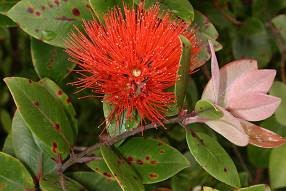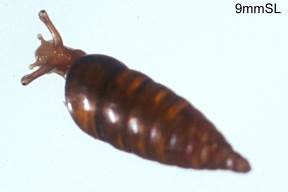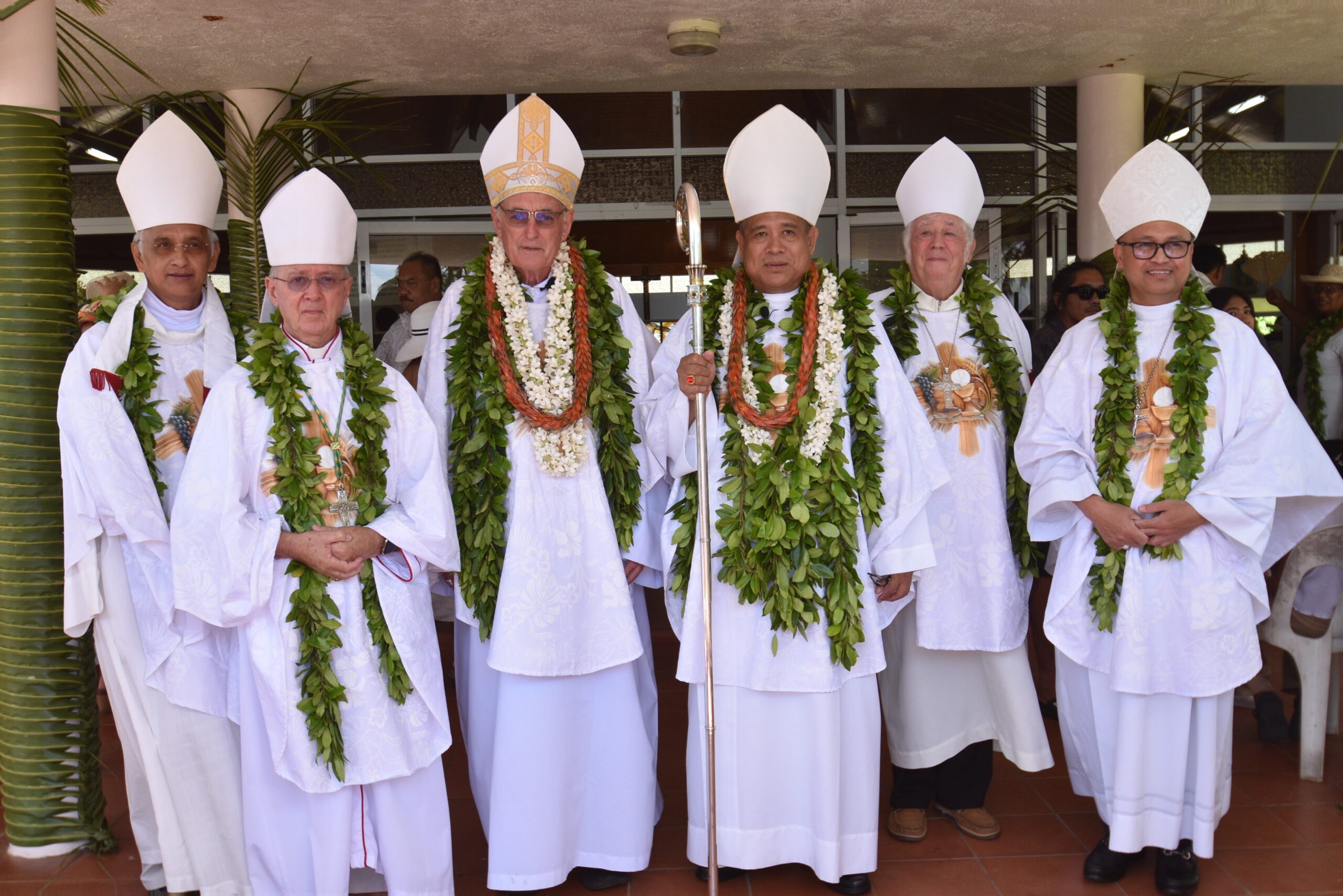Te Ko‘u summit biodiversity
Saturday 4 November 2023 | Written by Gerald McCormack | Published in Features, In Depth, Weekend

The form of our Rata on the summit of Te Ko‘u is the parent of the popular New Zealand ornamental Metrosideros “Spring Fire”. GMcCormack/ 23110320
The inland mountains of Rarotonga maintain one of the most pristine tropical forests in the Central South Pacific. Gerald McCormack of Cook Islands Natural Heritage Trust explains why.
The biodiversity crowning glory of the inland forest is in the Cloud Zone, which is recognised by the occurrence of two particular ferns.
Depending upon the rainfall, they grow down ridges to between 350 and 450 metres elevation. In 1988, I defined the Cloud Zone as above 400m as a compromise to facilitate the creation of a reserve including Te ‘Atukura (638m), Te Manga (653m) and Te Ko‘u (588m) within a contiguous block.
While Te Manga and Te ‘Atukura have pinnacle-like summits, Te Ko‘u is completely different with its basin-like summit. The oval basin measures about 200m North-South and 300m East-West with an area of about 5ha (12 acres). This basin is dissected by a small stream running west to east, where it has cut the summit rim into a deep V to cascade down a very steep valley into the Avanā.

The basin on the summit of Te Ko‘u viewed westward from Te Manga Cook Islands Biodiversity/ 23110324
During 40 years of periodic visits to the summit basin, I have always found the small stream emerging near the basin’s centre and trickling over an impervious clay embankment. This impervious barrier is probably the main structure holding back a large groundwater reservoir on the basin’s western side, enabling the stream to run continuously. The mountain’s high elevation causes frequent cloud cover and a high level of precipitation of about 4000mm, which is twice the annual rainfall of coastal Rarotonga.
The 1885 claim by the Reverend W. Wyatt Gill that Te Ko‘u is the “source of all the streams which fertilise the island” is false. Its stream is a continuous but relatively small contributor to the Avanā Stream, the largest stream on the island.
Here, we present information on a few species that make Te Ko‘u a Cloud Zone highlight.
Rata, Polynesian Metrosideros
In 1899, Thomas Cheeseman, the Curator of the Auckland Museum, spent three months researching the plants of Rarotonga, culminating in his Flora of Rarotonga of 1903. He recorded 267 flowering plants, of which 168 were native or indigenous, including 17 new species unique or endemic to the island.
He reported collecting Rata on ‘Ikurangi in his diary on the 27th of May, and on the 18th of June, on the summit of Te Ko‘u, he collected a different Rata, writing there are “apparently two species”. However, in his Flora, he accepted only one species (Metrosideros collina) with “two forms: one, …. has the young shoots and branches of the inflorescence silky or tomentose; the other … is nearly glabrous [without hairs], …”
The form he found on Te Ko‘u had a silky/hairy inflorescence and new leaves, and it is restricted to the Cloud Zone, where it is common. The other form, without a silky inflorescence, is common on the drier ridges above mid-elevation, such as on the ridge to the Needle and on the dry summit of ‘Ikurangi.
Although the silky Rata of Te Ko‘u has garnered little attention on Rarotonga, it is now known to be New Zealand’s most popular ornamental Metrosideros, Metrosideros “Sure Fire”. This connection was established by botanist Peter de Lange in 2011. Although it could not be determined when our Cloud Zone Rata was taken to New Zealand, the suspicion points to Cheeseman, who was also known to collect some live plants.
“Sure Fire” must have been popular before 1945 when it was selected to be planted on the Waitangi Treaty Grounds beside the Te Whare Runanga (Meeting House), where they are now about 15m high. After Cheeseman, William Philipson was the next Kiwi botanist to research Cloud Zone plants in 1969. This is too late, so Cheeseman probably took it to New Zealand.
Our Rata, Metrosideros collina, is a dramatically crimson-flowered shrub or gnarled tree to about 5m, also found on islands in the Australs and Societies. It is an endemic plant of Southeast Polynesia.
Rata Leafminer Moth
The Rata Leafminer Moth (Macarostola pontificalis) is a tiny, slender moth about 6mm long. Its tiny size is offset by its bright crimson and yellow markings.

The Rata Leafminer Moth has been found only on the summit of Te Ko‘u. GMcCormack/ 23110319
It has been found only on Te Ko‘u, where its caterpillar lives within the leaves of the Rata. The young caterpillar makes a narrow serpentine tunnel, which becomes wide and filled with waste at the edge of the leaf. The half-grown caterpillar emerges and moves to another leaf, where it cuts out a half-moon section attached at the end.
On the underside of the leaf, it uses silk to roll the section around itself into a tepee-like cone about 12mm high. It lives and feeds inside the cone until it gets its 5th and last skin, when it bites a hole to emerge. It moves to yet another leaf, where it folds the edge to make a silken tunnel in which it pupates and transforms into a moth.
This remarkable animal is found only on Rarotonga, Rurutu, Rapa ‘iti, Mo‘orea and Ra‘iātea – always at high elevations on Rata. It is an endemic of Southeast Polynesia.
Montane Emerald Dragonfly
The Cook Islands has seven dragonflies, and the rarest is the Montane Emerald Dragonfly, found almost exclusively in the summit basin of Te Ko‘u.

The Montane Dragonfly is the rarest dragonfly in the Cook Islands, and its only substantial population is on the summit of Te Ko‘u. GMcCormack/23110321
The Montane Emerald Dragonfly (Hemicordulia hilaris) has a distinctive metallic blue-green colour and a spindle-shaped abdomen. It is a small dragonfly with a 6cm wingspan, which at rest holds its wings level with its body, rather than forward and down, like the ubiquitous Small Red Dragonfly.
This emerald dragonfly is a strong flier with a wide distribution from New Caledonia and Vanuatu through Fiji, Tonga, and the Samoas to Rarotonga. The genus is still under taxonomic revision, and if the Tahitian species, Hemicordulia oceanica is the same, this would extend the range of our species to the Society Islands.
Dragonflies are usually seen around ponds of all sizes into which they lay their eggs, and their larvae (nymphs) live on the bottom, where they ambush their prey with their long, extendable mouthparts. When the nymphs reach their final stage, they crawl out of the water on some object. There, their skins split open, and the soft-bodied adults emerge to pump themselves into adult shape before their skins become rigid and coloured.
There are no ponds on Te Ko‘u, and where our young emerald dragonflies live is unknown.
Te Ko‘u Landsnail
Native landsnails have not done well on Rarotonga, with more known extinctions than all other animal groups combined. Most native coastal landsnails are extinct, and many mountain species are gone.

This is the only known photo of a live Te Ko‘u Landsnail. It was taken in 1984, and no more live animals have been found. Shell Length (SL) 9mm. GMcCormack/23110323
Te Ko‘u has proven to be a natural refuge for several species, and around 2007, snail expert Fred Brook found four new landsnail species surviving in the summit basin. They are not yet named.
Rarotonga's most famous native landsnail was found on the summit Te Ko‘u in 1964 and 1965. Kiwi Laurie Price found it for the American landsnail expert Alan Solem, who named it after the mountain and its finder Tekoulina pricei. Price found numerous specimens in areas of Cloud Blechnum within the summit basin but not elsewhere on the island.
All landsnails, including the Te Ko‘u Landsnail, are bisexual (hermaphroditic) with mature male and female reproductive parts. They produce young by mutual cross-fertilisation, although self-fertilisation can sometimes occur.
They typically produce large nutrient-filled eggs in which the embryos develop after being laid, although in many cases, the adult keeps the eggs inside where the young hatches to be born free-living. In such cases, each embryo grows on the nutrients within its egg and is not connected to the mother. This widespread type of live birth is known as ovatrophic viviparity (“egg-fed, live birth”) or ovoviviparity (“egg, live birth”).
In contrast, our Te Ko‘u Landsnail feeds its embryos while they grow in her uterus. The eggs are small with minimal nutrients, and the embryos are fed through a stalk or umbilicus attached to the uterus wall. This is called matrotrophic viviparity (“mother-fed, life birth”).
Mother-fed live births are incredibly rare in the world of snails. It occurs in only eighteen species worldwide, and our Te Ko‘u Landsnail is in this elite group.
The last live Te Ko‘u snail was seen and photographed by the author in 1984. Brook undertook thorough searches in 2005, 2006 and 2007 and found no live snails, although a few fresh, empty shells indicated that this endangered species might still exist.
Tuna Kavi, the Polynesian Longfin Eel
Rarotonga has three freshwater eels, the most common being the uniformly dark swamp eel Tuna Māori, the Pacific Shortfin Eel (Anguilla obscura). The common eel in the streams, especially at lower elevations, is the marbled eel Tuna Pupu, the Giant Marbled Eel (Anguilla marmorata).

Tuna Kavi, the Polynesian Longfin Eel, lives in the upper reaches of streams and has been recorded in the summit stream of Te Ko‘u. GMcCormack/ 23110322
The upper reaches of streams are the home of the slender Tuna Kavi, the Polynesian Longfin Eel (Anguilla megastoma). Over the years, a few hikers have reported seeing eels in the summit stream, and I found a 70cm eel in 1991. It was uniformly grey-brown above and had a yellowish belly.
There are two amazing things about Tuna Kavi being on the summit of Te Ko‘u. The first is the unbelievably steep valley it climbed to reach the top: a valley of several vertical waterfalls. I once attempted to hike up this stream and found it impossible to work my way around the edges of the waterfalls. How do eels sometimes make that climb?
The second thing is that I have not seen any prawns or fish for it to eat. I have heard that Tuna Kavi is the most vicious eel, and it has been found with the remains of rats inside. On the top of Te Ko‘u, the odd rat might be its main food source, although I imagine a few landsnails and insects also fall into the water or venture too close.
A final point about any Tuna Kavi on Te Ko‘u is that when it is about 20 years old, it will change from its usual yellow belly to silver, stop eating, and slither down the mountain to take the Avanā Stream to sea and use its body fat to undertake an ocean journey to a still unknown area where it will breed and die. Research in Samoa and elsewhere has shown that migrating eels swim about 800m deep during the day to avoid predators, mainly sharks, but come up to about 200m at night to warm up.
Finding the deep-water breeding sites of freshwater eels has been very difficult. The sites for only three species are known: the European, American, and Japanese Eels. For example, the European Eel leaves European streams as a silver eel to swim on its stored fats for about five months, covering 6000km to its breeding site about 500m deep in the Sargasso Sea, east of Bermuda. There, they spawn and die. Their leaf-like larvae take about three years to float on the Gulf Stream back to the Continental Shelf of Europe, where they become swimming “glass eels” which enter streams to become small pigmented eels (“elvers”) and then yellow eels. They change into migratory silver eels when they are about 20 years old.
The deep-water breeding sites of the tropical South Pacific eels are yet to be discovered. Tahiti has the same three eel species as Rarotonga, and their young transparent “glass eels” arrive during the early Wet Season (December-February). Their small size of about 50mm suggests they are only about four months old, indicating relatively nearby breeding sites. This might apply to Rarotonga eels also. There is a lot to learn.









































